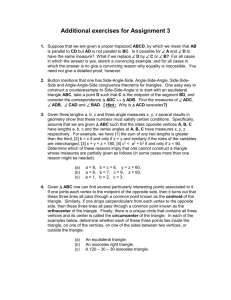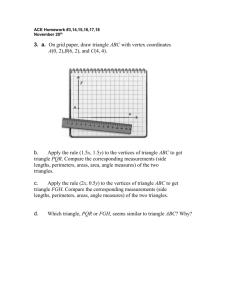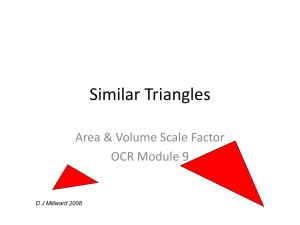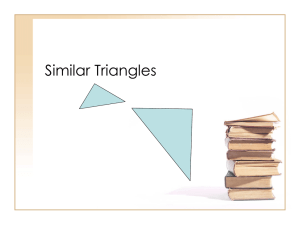MATH 4510/5510: Brown Definitions
advertisement
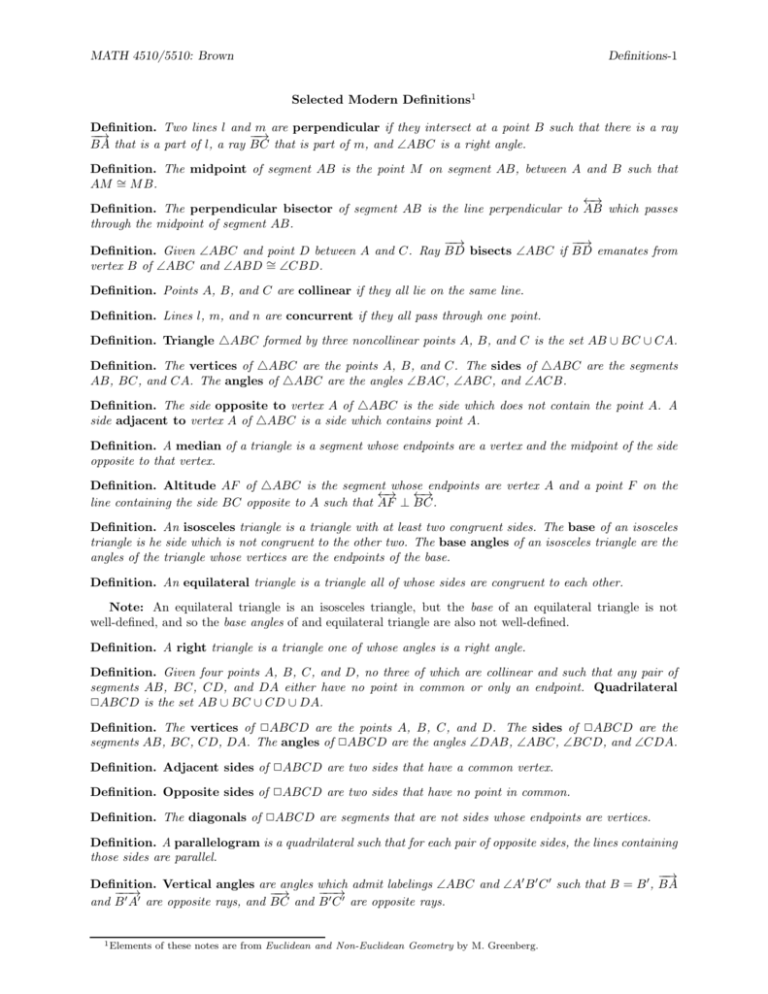
MATH 4510/5510: Brown Definitions-1 Selected Modern Definitions1 Definition. Two lines l and m are perpendicular if they intersect at a point B such that there is a ray −−→ −−→ BA that is a part of l, a ray BC that is part of m, and ∠ABC is a right angle. Definition. The midpoint of segment AB is the point M on segment AB, between A and B such that AM ∼ = M B. ←→ Definition. The perpendicular bisector of segment AB is the line perpendicular to AB which passes through the midpoint of segment AB. −−→ −−→ Definition. Given ∠ABC and point D between A and C. Ray BD bisects ∠ABC if BD emanates from vertex B of ∠ABC and ∠ABD ∼ = ∠CBD. Definition. Points A, B, and C are collinear if they all lie on the same line. Definition. Lines l, m, and n are concurrent if they all pass through one point. Definition. Triangle △ABC formed by three noncollinear points A, B, and C is the set AB ∪ BC ∪ CA. Definition. The vertices of △ABC are the points A, B, and C. The sides of △ABC are the segments AB, BC, and CA. The angles of △ABC are the angles ∠BAC, ∠ABC, and ∠ACB. Definition. The side opposite to vertex A of △ABC is the side which does not contain the point A. A side adjacent to vertex A of △ABC is a side which contains point A. Definition. A median of a triangle is a segment whose endpoints are a vertex and the midpoint of the side opposite to that vertex. Definition. Altitude AF of △ABC is the segment whose endpoints are vertex A and a point F on the ←→ ←→ line containing the side BC opposite to A such that AF ⊥ BC. Definition. An isosceles triangle is a triangle with at least two congruent sides. The base of an isosceles triangle is he side which is not congruent to the other two. The base angles of an isosceles triangle are the angles of the triangle whose vertices are the endpoints of the base. Definition. An equilateral triangle is a triangle all of whose sides are congruent to each other. Note: An equilateral triangle is an isosceles triangle, but the base of an equilateral triangle is not well-defined, and so the base angles of and equilateral triangle are also not well-defined. Definition. A right triangle is a triangle one of whose angles is a right angle. Definition. Given four points A, B, C, and D, no three of which are collinear and such that any pair of segments AB, BC, CD, and DA either have no point in common or only an endpoint. Quadrilateral ✷ABCD is the set AB ∪ BC ∪ CD ∪ DA. Definition. The vertices of ✷ABCD are the points A, B, C, and D. The sides of ✷ABCD are the segments AB, BC, CD, DA. The angles of ✷ABCD are the angles ∠DAB, ∠ABC, ∠BCD, and ∠CDA. Definition. Adjacent sides of ✷ABCD are two sides that have a common vertex. Definition. Opposite sides of ✷ABCD are two sides that have no point in common. Definition. The diagonals of ✷ABCD are segments that are not sides whose endpoints are vertices. Definition. A parallelogram is a quadrilateral such that for each pair of opposite sides, the lines containing those sides are parallel. −−→ Definition. Vertical angles are angles which admit labelings ∠ABC and ∠A′ B ′ C ′ such that B = B ′ , BA −−′−→′ −−′−→′ −−→ and B A are opposite rays, and BC and B C are opposite rays. 1 Elements of these notes are from Euclidean and Non-Euclidean Geometry by M. Greenberg.


